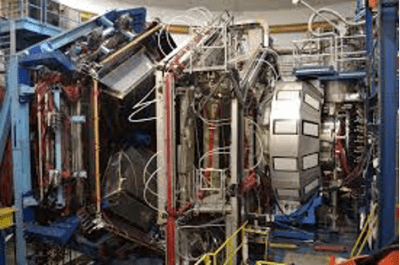Kyungseon Joo, a professor of physics, has been named Chair of the CLAS Collaboration, one of the largest international collaborations in nuclear physics. CLAS involves 50 institutions from 9 countries and has about 250 collaborators. The collaboration recently completed the upgrade of the CEBAF Large Acceptance Spectrometer (CLAS12) for operation at 11 GeV beam energy in Hall B at Jefferson National Laboratory in Newport News, VA, funded by the United States Department of Energy.
CLAS12 is based on a dual-magnet system with a superconducting torus magnet that provides a largely azimuthal field distribution that covers the forward polar angle range up to 35°, and a solenoid magnet and detector covering the polar angles from 35° to 125° with full azimuthal coverage. Trajectory reconstruction in the forward direction using drift chambers and in the central direction using a vertex tracker results in momentum resolutions of 1% and 3%, respectively. Cherenkov counters, time-of-flight scintillators, and electromagnetic calorimeters provide good particle identification. Fast triggering and high data-acquisition rates allow operation at a luminosity of 1035 cm−2s−1. These capabilities are being used in a broad scientific program to study the structure and interactions of nucleons, nuclei, and mesons, using polarized and unpolarized electron beams and targets for beam energies up to 11 GeV.
As Chair, Joo represents the collaboration in scientific, technical, and managerial concerns, while he closely works with the Lab management on scheduling experiments, organizing collaboration activities and expanding the reach of the collaboration. He currently focuses on collaboration-wide efforts to timely make first publications from CLAS12 with high impact science.
